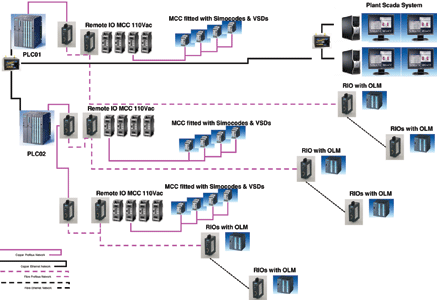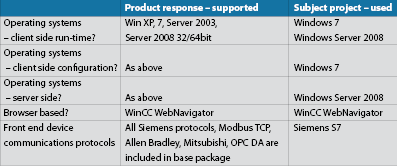

Click here for .pdf file.
End-user details
Name: Details not provided by vendor
SI details
Name: Gerhard Kamffer
Designation: Engineering manager
Company: Kairos Control Systems
Phone: +27 (0)11 792 8558
E-mail: [email protected]
Product details
Product name: Siemens Simatic WinCC 7.0 and version: Sp3 Simatic Step 7 v5.5
Vendor: Siemens
Phone: +27 (0)11 652 2000
E-mail: [email protected]
URL: www.automation.siemens.com
Application details
Industry: Metallurgical
Application: Minerals processing
Server OS: Windows Server 2008
Client OS: Windows 7
Application statistics
Tag count: 71 452
Front ends: 600 DIO and 400 AIO across: 2 x Siemens S7-400 (416 CPUs); 19 x ET200M Remote IO stations; 194 * Siemens Simocode motor controllers; 54 * Weg CFW 09 VSDs; 3 * Process Automation ACCUWEIGH Scales; 1 * LAROX filter press
Licences: WinCC v7.0 Configuration 102 400 tags with 512 archive tags; WinCC v7.0 Runtime 102 400 tags with 512 archive tags; WinCC v7.0 Server; WinCC v7.0 1500 archive tags; 2 * WinCC v7.0 Client RT; WinCC v7.0 WebNavigator with 10 client licence; Simatic S7, Step7 2010 Professional; Simocode ES Professional 2007 premium
END-USER RESPONSES
General
Q: Briefly describe the application including information on any pre-existing control system.
The application was for a greenfield project for the processing of ore to recover lead and zinc. Ore is crushed, milled and processed through floatation plants then passed through thickeners to obtain a high grade product in the form of slurry. The slurry is dewatered through filter presses and then stored in bunkers.
Q: What was the primary motivation for the project?
To provide control and automation on a greenfield mineral processing project.
Q: What Project Management principles and/or methodologies did you employ as end-user to mitigate risk, ensuring the pro-ject came out on time and within budget?
None. Project management was handled by the SI.
Licensing, maintenance and support
Q: What upgrade agreements are in place for this application?
Provision has been made to upgrade the system to handle a second mill and additional thickeners.
Q: How is after-sales support handled on this application?
Support is provided by the SI and vendor.
System architecture
Q: Do you run the scada in conjunction with any third-party application software (Other than MES)?
No.

Management reporting and integration
Q: Does the application include data archiving / historian capabilities with an historical data reporting system?
Yes. 950 tags of process data and technical information are archived.
Q: Is the system integrated with an MES / ERP or other management reporting or control system? (e.g. Baan, SAP, SYSPRO…)
No.
Q: Have any production benchmarking tools been configured as part of the scada system?
No.
Q: Has any asset management functionality been configured in the application (for software assets, control system assets or for plant assets)?
No.
Q: Has any GIS (Geographic Information Systems) functionality been configured in the application?
No.
Q: Are you using tablet PCs or mobile phones to interact with this scada system?
Yes. Monitoring and control on a tablet via WinCC WebNavigator.
End-user conclusion
Q: What was the predominant feature (or features) that made you decide to purchase this scada product over all others for this application?
The scada product selection was made by the SI who has developed a wide range of standards on WinCC and has a great relationship with Siemens’ staff. The SI believes that the WinCC scada surpasses its competitors in suitability and its software architecture minimises engineering time.
Q: What single feature most impresses you about the product now that it is in operation?
The enhanced features of the controls provided with WinCC to visualise trends and alarms.
Q: What impresses you most about the architecture?
Its upgradability and incorporation of open standards.
SI RESPONSES
Project details
Q: Approximately how many man-hours did the scada configuration take?
420 man-hours.
Q: What tools were used to minimise the man-hours taken?
* WinCC Excel tools for alarming and structure tag generation.
* Network Automation’s Automate software for general tag generation.
* WinCC Basic Process Control.
Q: What human factors were taken into consideration in the HMI design process?
* Ease of use for operator with clear visibility of process data in the form of online and historical trends.
* Standardised colour usage for alarm, fault and running indications. The colour usage in general is easy on the eyes.
* Easy screen navigation in the form of WinCC basic process control.
* All plant status and relevant information are visible on the scada to eliminate the need for fault finding in the PLC code.
* All interlock indications, faults and sequencing steps are explained in the form of text massages,
* Motor faceplate information includes motor names, locations, MCC cubicle numbers and node addresses along with all relevant fault and status information.
* Valve faceplates include valve names, locations, I/O numbers and all relevant fault and status information.
* Analog and digital faceplates include the instrument descriptions, RIO panel number and I/O numbers.
* Scale information and status are also displayed.
Q: For the graphics development process did you use standard library images, or did you have to draw images from scratch?
All images were drawn from scratch to mimic P&ID drawings.
Q: How would you describe the library of graphic images?
Not easy to apply on project-specific applications. The best look and feel for a scada is achieved through custom graphics.
Q: Did you use any ‘special’ images (e.g. photographs, 3D images, specialised dashboards, etc.)?
Yes. Bitmaps for alarm indication and scada icons.
Q: Did you use any video or multimedia technology in the application?
No.
Q: What alarm management standards or best practices were adopted in configuring the scada system alarms?
For alarming the project used WinCC Alarm Control, Basic Process Control, custom critical alarms and area specific alarms.
Q: What are the key physical communication layers and communication protocols employed in the system?
Fibre Ethernet ring and Profibus DP fibre ring on all 7 Profibus networks split over 2 * S7 400 (416) PLCs.
Q: What levels of redundancy are incor-porated in this scada application?
Two WinCC clients with WebNavigator backup. No redundant servers were required.
Q: What specific custom code or scada scripts were written for this project?
Customisation of WinCC Basic Process Control to work on a standard WinCC project, PLC communication monitoring, text based description on all faceplates and interlock indication using VB scripting.
Project management
Q: What Project Management principles and/or methodologies did you as SI employ to mitigate risk and to ensure the project came out on time and within budget?
Kairos Control Systems’ engineering processes are managed by a strict code of practice governing every facet of a project and are described in Kairos’ document ‘The Project Quality Process’.
Security and data protection
Q: How have authentication, authorisation and role management been configured?
We used SIMATIC Logon for user administration in operator control and monitoring.
Q: Does the design make provision for a DMZ and firewall segregation of process (scada) network and business networks?
The WebNavigator server provides Internet access via a second network card on the PC. This server connects to the control network via a firewall.
Q: What intrusion detection has been incorporated on the plant network(s) on which this scada system exists?
None.
Q: What configuration backup and data archive backup methodologies have been adopted?
The SQL database is backed up to a network backup device.
Q: Did you use any integrated or third party configuration control system for the scada configuration during the engineering of this application?
Yes. Network Automation’s Automate software for generating tags from IO- and motor lists.
SI conclusion
Q: How would you rate the ease of use of the historical reporting system?
Very good and easy to set up and use.
Q: What impresses you the most about the engineering / configuration aspects of the product now that it is in operation?
Its stability.
Q: What impresses you most about the architecture?
* Ease of use in conjunction with SIMATIC hardware.
* The use of structure tags tag generation after a structure has been set up saves a great deal of engineering time.
* Archive and alarm configuration makes it easy to change messages without having to stop the runtime.
* The ability to add new scada clients without needing to stop production or cause down time.
VENDOR RESPONSES
Product
See Table 1.

Operating systems / VMware
See Table 2.

Licensing, maintenance and support model
Q: What sort of licensing agreement options are offered?
The base licence comprises core modules with pricing based on tag count. Options such as WebNavigator, DataMonitor, Batching and Maintenance can be purchased separately.
Q: Are licences sold outright or subject to periodic (e.g. annual) renewal?
Licence is a once-off purchase for a particular version.
Q: What upgrade agreements are offered?
Annual maintenance is available through a Software Update Service package that covers any upgrades, including version upgrades, for all WinCC modules on a per computer basis.
Q: What after-sales offerings iro support and maintenance are available, and which technologies are used to deliver them?
Siemens Industry Support can be contracted for service agreements.
Technology incorporated
See Table 3.

Q: What new technology has been introduced into the product in the last 12 months?
A new Process Historian and Information Server have been added to the WinCC product suite to provide more advanced features based on the built-in MS SQL Server and MS SQL Server Reporting Services.
Management reporting and integration
Q: What native historical data reporting options are available?
WinCC native reporting package and the optional Information Server’s reporting based on MS SQL RS.
Q: What product specific interfaces does the product have iro well-known MES packages?
The PM option allows for connection with SAP and also the standard SIMATIC IT MES suite of products.
PLC configuration and programming
Q: What capabilities does the scada offer in terms of generation and/or management of PLC configuration files or PLC application code?
Through TIA integration of WinCC into STEP7 all tags and alarms are automatically generated inside WinCC eliminating manual list generation.
Security and data protection
Q: What authentication, authorisation and role management models are available for the runtime environment?
Freely configurable security groups, users, and authorisations can be configured in WinCC. Users can optionally be connected with the Windows Workgroup or Domain Users for further features like password complexity and ageing.
Unique selling proposition (USP)
Q: List the top five feature/benefit pairs that contribute to this product’s USP.
* Total integration with STEP7 Manager – rapid development and auto generation of tags and alarms.
* PLC, network equipment and scada from the same R&D team – seamless integration.
* Web functionality – automatic publishing of mimics to web enabled format through a wizard, data transparency, Excel integration.
* Proven architecture – reliability.
* Built-in MS SQL Server – advanced archive and alarming features built into the base packages.
| Tel: | +27 11 652 2000 |
| Email: | [email protected] |
| www: | www.siemens.co.za |
| Articles: | More information and articles about Siemens South Africa |

© Technews Publishing (Pty) Ltd | All Rights Reserved